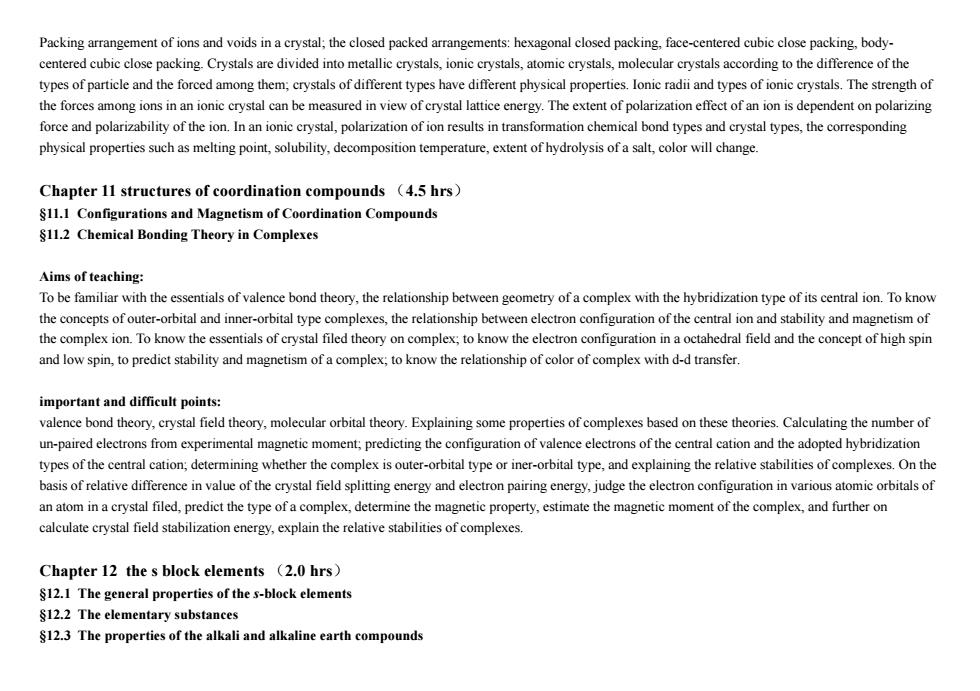正在加载图片...

Packing arrangement of ions and voids in a crystal;the closed packed arrangements:hexagonal closed packing,face-centered cubic close packing,body- centered cubic close packing.Crystals are divided into metallic crystals,ionic crystals,atomic crystals,molecular crystals according to the difference of the types of particle and the forced among them;crystals of different types have different physical properties.Ionic radii and types of ionic crystals.The strength of the forces among ions in an ionic crystal can be measured in view of crystal lattice energy.The extent of polarization effect of an ion is dependent on polarizing force and polarizability of the ion.In an ionic crystal,polarization of ion results in transformation chemical bond types and crystal types,the corresponding physical properties such as melting point,solubility,decomposition temperature,extent of hydrolysis of a salt,color will change. Chapter 11 structures of coordination compounds (4.5 hrs) $11.1 Configurations and Magnetism of Coordination Compounds $11.2 Chemical Bonding Theory in Complexes Aims of teaching: To be familiar with the essentials of valence bond theory,the relationship between geometry of a complex with the hybridization type of its central ion.To know the concepts of outer-orbital and inner-orbital type complexes,the relationship between electron configuration of the central ion and stability and magnetism of the complex ion.To know the essentials of crystal filed theory on complex;to know the electron configuration in a octahedral field and the concept of high spin and low spin,to predict stability and magnetism of a complex;to know the relationship of color of complex with d-d transfer. important and difficult points: valence bond theory,crystal field theory,molecular orbital theory.Explaining some properties of complexes based on these theories.Calculating the number of un-paired electrons from experimental magnetic moment,predicting the configuration of valence electrons of the central cation and the adopted hybridization types of the central cation;determining whether the complex is outer-orbital type or iner-orbital type,and explaining the relative stabilities of complexes.On the basis of relative difference in value of the crystal field splitting energy and electron pairing energy,judge the electron configuration in various atomic orbitals of an atom in a crystal filed,predict the type of a complex,determine the magnetic property,estimate the magnetic moment of the complex,and further on calculate crystal field stabilization energy,explain the relative stabilities of complexes. Chapter 12 the s block elements (2.0 hrs) $12.1 The general properties of the s-block elements $12.2 The elementary substances $12.3 The properties of the alkali and alkaline earth compoundsPacking arrangement of ions and voids in a crystal; the closed packed arrangements: hexagonal closed packing, face-centered cubic close packing, bodycentered cubic close packing. Crystals are divided into metallic crystals, ionic crystals, atomic crystals, molecular crystals according to the difference of the types of particle and the forced among them; crystals of different types have different physical properties. Ionic radii and types of ionic crystals. The strength of the forces among ions in an ionic crystal can be measured in view of crystal lattice energy. The extent of polarization effect of an ion is dependent on polarizing force and polarizability of the ion. In an ionic crystal, polarization of ion results in transformation chemical bond types and crystal types, the corresponding physical properties such as melting point, solubility, decomposition temperature, extent of hydrolysis of a salt, color will change. Chapter 11 structures of coordination compounds (4.5 hrs) §11.1 Configurations and Magnetism of Coordination Compounds §11.2 Chemical Bonding Theory in Complexes Aims of teaching: To be familiar with the essentials of valence bond theory, the relationship between geometry of a complex with the hybridization type of its central ion. To know the concepts of outer-orbital and inner-orbital type complexes, the relationship between electron configuration of the central ion and stability and magnetism of the complex ion. To know the essentials of crystal filed theory on complex; to know the electron configuration in a octahedral field and the concept of high spin and low spin, to predict stability and magnetism of a complex; to know the relationship of color of complex with d-d transfer. important and difficult points: valence bond theory, crystal field theory, molecular orbital theory. Explaining some properties of complexes based on these theories. Calculating the number of un-paired electrons from experimental magnetic moment; predicting the configuration of valence electrons of the central cation and the adopted hybridization types of the central cation; determining whether the complex is outer-orbital type or iner-orbital type, and explaining the relative stabilities of complexes. On the basis of relative difference in value of the crystal field splitting energy and electron pairing energy, judge the electron configuration in various atomic orbitals of an atom in a crystal filed, predict the type of a complex, determine the magnetic property, estimate the magnetic moment of the complex, and further on calculate crystal field stabilization energy, explain the relative stabilities of complexes. Chapter 12 the s block elements (2.0 hrs) §12.1 The general properties of the s-block elements §12.2 The elementary substances §12.3 The properties of the alkali and alkaline earth compounds